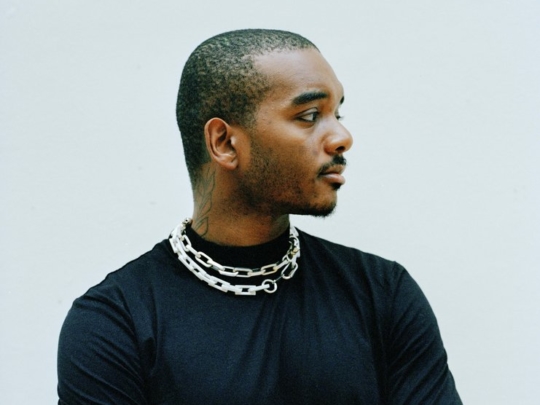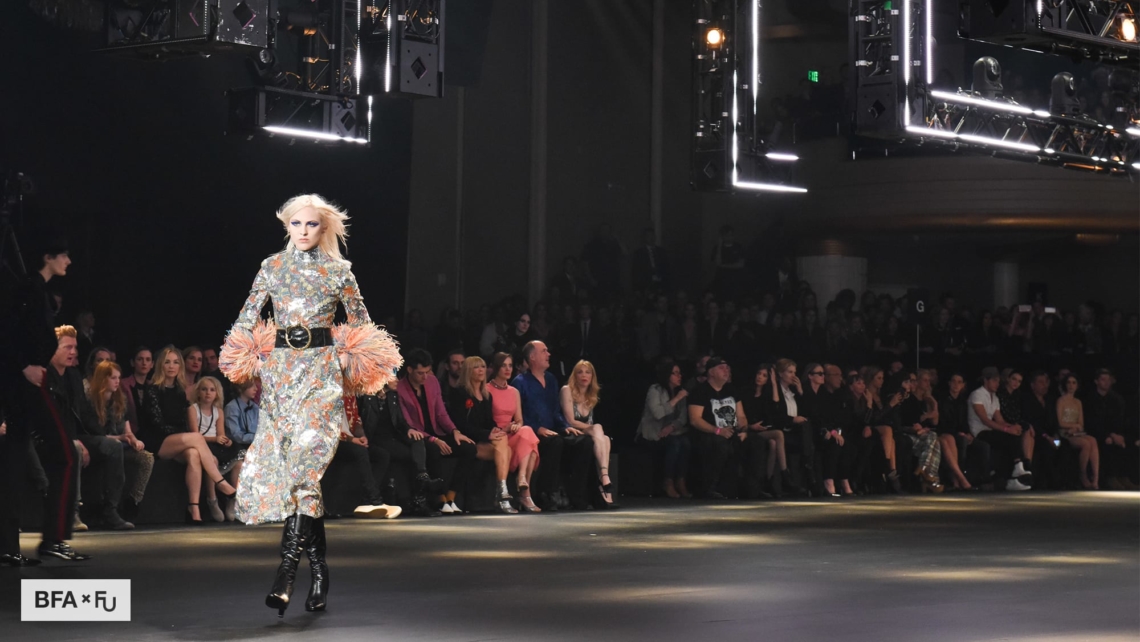Today, in the wee hours of the morning, Yves Saint Laurent confirmed Hedi Slimane’s departure. According to industry sources, the designer’s contract expired yesterday, and Anthony Vaccarello is allegedly on deck to replace him. An announcement is expected in the near future. “What Yves Saint Laurent has achieved over the past four years represents a unique chapter in the history of the house,” said François-Henri Pinault, chairman and CEO of Yves Saint Laurent’s parent company, Kering, in a statement. “I am very grateful to Hedi Slimane, and the whole Yves Saint Laurent team, for having set the path that the house has successfully embraced, and which will grant longevity to this legendary brand.”
The news is shocking.
No, no. It’s not surprising. This is not a surprise. Everyone in the industry has known about—or, at the very least, suspected—Slimane’s exit for months. Rumors have swirled. Editors at all the major magazines have had their farewell posts and greatest hits slideshows (you can see ours here!) prepared for weeks. Slimane’s fashion month double-header—comprising a men’s and women’s show in L.A., and then a couture outing in Paris—was a pretty blatant au revoir. Hell, he literally soundtracked his L.A. romp with a song called “She’s Gone.” If that doesn’t say “Peace out!” I don’t know what does. And the house wasn’t even particularly tight-lipped about it. When asked about Slimane’s contract by WWD in L.A., Pinault said, “We’re discussing. We have till the end of March. No rush.”
The writing was on the wall. But it’s still shocking, largely because Slimane’s rebranding of Saint Laurent (and subsequent success—his clothes flew off the racks) was so aggressive. What was once Yves Saint Laurent became the Hedi Slimane show. During his four-year tenure, Slimane created an entire grunge-glam world with which the coolest consumers on the planet became completely obsessed. It was his lifestyle, his vision, his L.A. musician muses that helped make his supremely wearable clothes so covetable. Vaccarello (or whomever takes over) is going to have one hell of a time picking up where Slimane left off, and an even harder time carving out his own legacy. “If I were a designer, and I were offered Yves Saint Laurent, I would seriously think about it before I took the job,” said prolific stylist George Cortina. “The comparisons are going to be too big, and what Hedi’s done in four years with everybody saying it was terrible and it was never going to work and it was a copy and it was the Kooples and it was Zadig & Voltaire, it was like every single designer in Paris has copied Hedi. It’s very difficult to find someone to fill his shoes and what he’s done because I think it takes a lot of intelligence.”
Slimane, who revolutionized menswear at both Saint Laurent in the late ’90s and, most notably, Dior Homme in the early 2000s with his impossibly slim tailoring, had left design to focus on photography before he was appointed as the creative director of Yves Saint Laurent in 2012. He stunned the industry when he dropped “Yves” from the ready-to-wear collection’s name, thus removing Saint Laurent the man from Saint Laurent the brand. He stunned them again when he moved the storied French house’s headquarters from Paris to L.A. where his musical muses resided. He infuriated editors with his first show, giving critics and fashion directors second row seats—or worse, standing. What’s more is that he waged war against Cathy Horyn, who was then the chief fashion critic of the New York Times, banning her from his runway spectacle and penning an open letter on Twitter in which he called her “a schoolyard bully and also a little bit of a stand-up comedian.” (I was sitting at dinner with a now former member of the brand’s PR team when Slimane sent out the tweet, and even he seemed visibly uncomfortable about the vitriolic note.) The Business of Fashion’s Imran Amed wrote a story tearing down the house’s convoluted new PR strategy, and journalists from outlets around the world complained about the treatment they received and Slimane’s clothes, calling them referential, disrespectful, cheap, grossly overpriced, and simply not fashion.
But none of that mattered. Slimane’s debut Spring 2013 Saint Laurent show, with its skinny trousers, sequin jackets, billowing caftans, pussy bow blouses, and wide-brimmed hats, was everything that savvy urban girls wanted to wear (maybe because some were already wearing it). Ahead of the show, Yves Saint Laurent’s muse, Betty Catroux, who joined the likes of Jamie Bochert, Kate Moss, Jamie Hince, Alison Mosshart, Catherine Deneuve, the late Saint Laurent’s partner Pierre Bergé, Azzedine Alaïa, and Raf Simons in the front row, told WWD that she backed Slimane’s new vision. “All Hedi’s decisions are brilliant,” she cooed. “And it is so clever of him to work in Los Angeles—in peace, away from everything, under the sun.”
Consumers loved it, too. They bought it all, and continued to do so—according to Kering’s recent financial report, Saint Laurent’s sales increased 37 percent in 2015 alone. So why was everyone so pissed off? “I think that the reaction to Hedi Slimane’s work has, from the beginning, been divided between those who felt that he was not original aesthetically and those who felt that he was commercially brilliant,” explained fashion historian and director and chief curator of the Museum at FIT, Dr. Valerie Steele. “From the first show, the audience was divided between a lot of fashion journalists and editors who said, ‘Uh, hello—this is nothing new. It’s just retreads of late ’60s and early ’70s [styles].’ And buyers from stores who said, ‘Oh my god, this is gonna sell, sell, sell!’ But he’s been very thin-skinned about any criticism,” she added. “And that, of course, always has the effect of contributing to more criticism.”
“He didn’t really care about anyone unless they were people that he thought were cool or had supported him,” offered Cortina. “He did what he wanted, and people didn’t like that. And that second [Fall 2013] collection, everyone was like, ‘Hedi is awful! It’s terrible! How could you do that to Saint Laurent?’ Oh, please. Grow up. Saint Laurent was my favorite designer and I saw that collection and thought, Oh my god, this is fucking genius. Yes, Marc [Jacobs] had done the grunge thing, but not with the Saint Laurent grease in the back and the Saint Laurent prints. And it was a very long time ago. People don’t remember.”
Slimane actually adhered to house codes quite closely, both in aesthetic and in free-spirited, party-girl essence. He just gave them an updated, newsworthy twist. “I think consumers like it because it’s very high quality clothing that is nonetheless not hard to understand because it’s similar enough to things that they have seen before,” says Steele of the house’s commercial popularity. “Most people are happier with clothes that look somewhat familiar.” Cortina, meanwhile, equates Slimane’s contribution to Saint Laurent to what Karl Lagerfeld did for Chanel in the 1980s. “When Karl sent out his motorcycle collection, it wasn’t new. But it was new for Karl and it was certainly new for Chanel. What Hedi did may not have been new, but it was news and you wanted to see the girls wearing it. And if I were a kid, I would steal my mother’s credit cards and have all of those things.”
If girls and boys in Paris, Milan, New York, L.A., and beyond can’t get their mother’s credit cards, they’re heading out to the high street and buying skinny jeans, jackets, baby doll dresses, tiaras, and fishnets in order to capture a whiff of the Slimane perfume. Whether intentional or not, designers have done the same. I challenge you to look at ten collections from the Fall 2016 season and not see Slimane’s influence in at least a third of them. “It’s a super accessible aesthetic, but also for fashion, it changes the way you look at things because all of a sudden it becomes about youth instead of these old corporate brands,” continued Cortina. “And it has a very direct link to what Saint Laurent did in the late ’60s, when he tore away from all of that grand couture and started doing things that were cooler—things he even got booed for, for being vulgar. The [1971 “Scandal”] collection was booed off stage.”
When it comes to the question of legacy, it’s plain to see that Slimane has created one during his time at Saint Laurent. Though Steele is unsure exactly what that legacy will be. “We can certainly say that when he was doing menswear at Dior he left a very strong legacy because he was instrumental in creating a new silhouette for men. A lot of people were imitating that. It’s more difficult to say what his legacy will be [at Saint Laurent] because legacy tends to focus on two things: originality and influence. And since the influence part is very difficult to track and the originality part is highly contested, it’s very difficult at this point in time to see what his legacy would be.”
Whether or not you agree that Slimane has been driving the mainstream aesthetic, it’s impossible to argue that he hasn’t injected a vibrancy into French fashion. Of course there were designers doing beautiful things before he took Saint Laurent’s helm, but during a rather drab period, when minimalism reigned supreme, Slimane came in and made fashion thrilling again. He made it scandalous again, shockingagain—right up to his shocking departure.
When I posed this question of legacy to Cortina, he responded that, during his stint at Saint Laurent, Slimane will be remembered for “absolutely changing Paris and making it look old. When he did that [Fall 2013] grunge collection, everything we saw that season looked like old women’s clothes. And I think fashion is about youth.” But fashion isn’t just about youth—it’s also about excitement, an intangible emotional rush. Slimane gave us that. “He did a perfect Loulou de la Falaise [another of Yves’ iconic muses] collection [in L.A.] and made everyone fall in love with it, and then he turned around and did an ’80s collection for couture, which makes all of that streetwear—that stupid word everybody’s using—seem irrelevant because we’re discussing fashion again.”
I’m curious about what Slimane’s departure says about the current state of the industry. We’ve seen a plethora of designer exits and switch-ups of late—in the last year, Raf Simons left Dior (yet to be replaced—any interest, Hedi?); Frida Giannini left Gucci, who then appointed Alessandro Michele; Alber Elbaz was pushed out of Lanvin and Bouchra Jarrar was brought in; at Balenciaga, Alexander Wang was swapped for Demna Gvasalia; and now, Hedi’s out at Saint Laurent, and his post is possibly (probably) soon to be filled by Anthony Vaccarello. Are we in the midst of a fashion apocalypse? Probably not. This tends to happen every few years. However, the previous round of musical chairs (Simons to Dior, Slimane to Saint Laurent, Nicolas Ghesquière to Louis Vuitton) consisted of headstrong design titans not easily pushed around by corporate houses, while this edition focuses on up-and-comers. Also, why is Slimane leaving? Rumors abound—some salacious, others quite boring—but none have been confirmed. Naturally, there’s going to be a frenzy when Kering officially announces Slimane’s successor. But Steele says, in so many words, to chill out. “I don’t think it’s going to create that many waves unless something really unusual comes out about why the split [between Slimane and Saint Laurent] was made. People got very, very anxious when Raf, Alber, and Alexander left all within a few months of each other, but when you step back and look at it, only Raf was saying, ‘I’m leaving because the speed of fashion is not in accordance with my own creative process.’ The others had more routine—unfortunate, but routine—reasons that didn’t apply to a crisis in fashion.”
Slimane’s leaving may not be a crisis, but from the moment he moved the atelier to L.A. to the closing look of his Paris couture outing (which, by the way, was the ultimate ode to Yves Saint Laurent, and an impossibly glamorous fuck you to his critics), the designer’s tenure has been a divisive, profitable rollercoaster. I’m anxious to see what, if anything, he’ll do next, whether his successor will be able to climb out from under his shadow, and if the house will reinstate Yves in its moniker. “I don’t know,” said Steele to that last question. “People don’t like to be confused by a lot of changes. On the other hand, people forget very quickly.”





